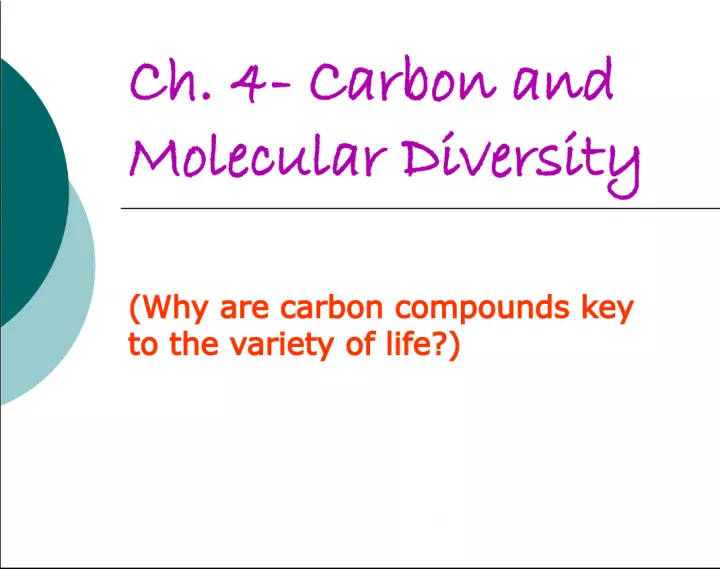Carbon and Molecular Diversity: The Key to Life's Variety


This chapter delves into the importance of carbon-based compounds in the diversity of life. Despite cells being mostly composed of water, the remaining components are largely made up of carbon
- Uploaded on | 3 Views
-
 noahjones
noahjones
About Carbon and Molecular Diversity: The Key to Life's Variety
PowerPoint presentation about 'Carbon and Molecular Diversity: The Key to Life's Variety'. This presentation describes the topic on This chapter delves into the importance of carbon-based compounds in the diversity of life. Despite cells being mostly composed of water, the remaining components are largely made up of carbon. The key topics included in this slideshow are . Download this presentation absolutely free.
Presentation Transcript
Slide1Ch. 4- Carbon andMolecular Diversity (Why are carbon compounds key to the variety of life?)
Slide2Although cells are 70-95% water, the rest consists mostly of carbon-based compounds. Proteins, DNA, carbohydrates, and lipids are all composed of carbon atoms bonded to each other and to atoms of other elements. These other elements commonly include hydrogen (H), oxygen (O), nitrogen (N), sulfur (S), and phosphorus (P). A. Introduction
Slide3The study of carbon compounds, organic chemistry, focuses on any compound with carbon (organic compounds). Organic compounds can range from the simple (CH 4 ) to complex molecules, like proteins, that may weigh over 100,000 daltons. B. Organic chemistry is the study of carbon compounds
Slide4Because of carbon’s versatility, these few elements can be combined to build an inexhaustible variety of organic molecules.
Slide5With a total of 6 electrons, a carbon atom has 2 in the first shell and 4 in the second shell. Carbon has little tendency to form ionic bonds by losing or gaining 4 electrons. Instead, carbon usually completes its valence shell by sharing electrons with other atoms in four covalent bonds. C. Carbon atoms are the most versatile building blocks of molecules
Slide7Carbon chains form the skeletons of most organic molecules. The skeletons may vary in length and may be straight, branched , or arranged in closed rings. The carbon skeletons may also include single , double and triple bonds.. D. Variation in carbon skeletons contributes to the diversity of organic molecules
Slide9Hydrocarbons are organic molecules that consist of only carbon and hydrogen atoms. Fats are biological molecules that have long hydrocarbon tails attached to a non-hydrocarbon component.
Slide10Isomers are compounds that have the same molecular formula but different structures and therefore different chemical properties . For example, butane and isobutane have the same molecular formula C 4 H 10 , but butane has a straight skeleton and isobutane has a branched skeleton.
Slide11Enantiomers are molecules that are mirror images of each other. They are like left-handed and right-handed versions. Usually one is biologically active, the other inactive.
Slide12The components of organic molecules that are most commonly involved in chemical reactions are known as functional groups . The number and arrangement of functional groups help give each molecule its unique properties. E. Functional groups contribute to the molecular diversity of life
Slide13There are six functional groups that are most important to the chemistry of life: hydroxyl, carbonyl, carboxyl, amino, sulfhydryl, and phosphate groups . All are hydrophilic and increase solubility of organic compounds in water .
Slide14In a hydroxyl group (-OH), an OH group forms a polar covalent bond to the carbon skeleton. Because of these polar covalent bonds hydroxyl groups improve the solubility of organic molecules. Organic compounds with hydroxyl groups are alcohols and their names typically end in -ol .
Slide15A carbonyl group (=CO) consists of an oxygen atom joined to the carbon skeleton by a double bond . If the carbonyl group is on the end of the skeleton, the compound is an aldehyde . If the carbonyl group is in the middle of the skeleton, then the compound is a ketone. Aldehydes and ketones give different personalities to the molecules they are part of.
Slide16A carboxyl group (-COOH) consists of a carbon atom with a double bond with an oxygen atom and a single bond to a hydroxyl group. Compounds with carboxyl groups are organic acids. A carboxyl group acts as an acid because the molecule can form the H+ in solution. Fatty acids and amino acids have carboxyl groups.
Slide17An amino group (-NH 2 ) consists of a nitrogen atom attached to two hydrogen atoms and the carbon skeleton. Organic compounds with amino groups are amines. The amino group acts as a base because ammonia can pick up a hydrogen ion (H + ) from the solution. Amino acids, the building blocks of proteins, have amino and carboxyl groups .
Slide18A sulfhydryl group (-SH) consists of a sulfur atom bonded to a hydrogen atom and to the backbone . This group resembles a hydroxyl group in shape. Sulfhydryl groups help stabilize the structure of proteins.
Slide19A phosphate group (-OPO 3 2- ) consists of phosphorus bound to four oxygen atoms (three with single bonds and one with a double bond). Phosphate groups carry a negative charge. Nucleic acids like DNA, and RNA have phosphate groups which allows them to be drawn towards a positive charge in an electric field. One function of phosphate groups is to transfer energy between organic molecules.
Slide20Living matter consists mainly of carbon, oxygen, hydrogen, and nitrogen, with smaller amounts of sulfur and phosphorus. These elements are linked by strong covalent bonds. Carbon with its four covalent bonds is the basic building block in molecular architecture. The great diversity of organic molecules with their special properties emerge from the unique arrangement of the carbon skeleton and the functional groups attached to the skeleton. F. The chemical elements of life: a review